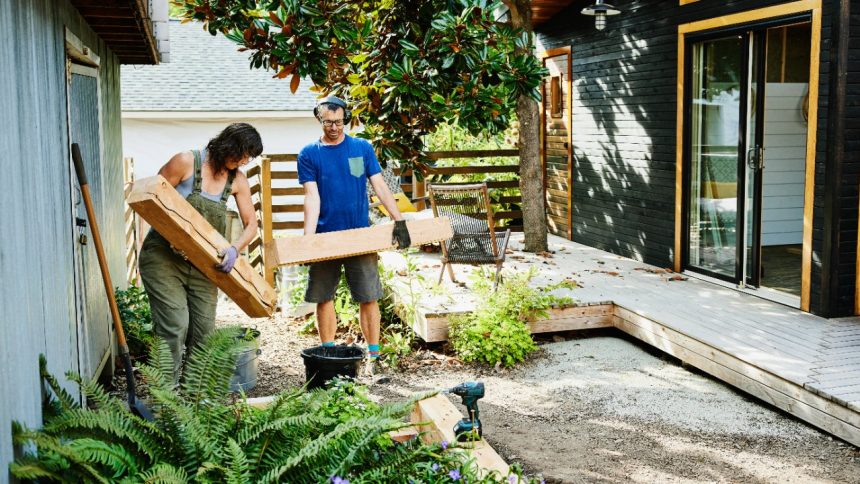Key takeaways
- The right home improvements can boost your home’s value and make it more functional.
- If you don’t have the budget for a big renovation, there are small projects you can do on your own without breaking the bank.
- For the projects that cost more than you want to spend in cash, consider a home improvement loan, a 0 percent APR credit card or home equity financing.
Whether it’s to improve property value or enhance their living experience, homeowners are increasingly looking to touch up their living (and, in many cases, working-from-home) spaces on a budget. DIY home renovations can be an economical way to transform your space, but they can easily become pricey if you’re not careful. With a bit of education and planning, however, there are plenty of ways to give your home a facelift that don’t involve having to borrow or spend a fortune.
Here are 10 ideas for DIY home remodeling projects on a budget, plus a few ways to pay for them if you don’t have the cash.
10 DIY home improvements on a budget
1. Repaint the front door
Average cost: $135-$300
Your front entrance is like the gift wrapping for your home, making it feel inviting and drawing people in when done right. Rather than buying a new door, spring for a fresh coat of paint, new hardware and spruced-up trim. Repainting the door and updating the accents around it are simple, inexpensive renovations that can drastically change your home’s appearance.
But don’t stop at the door. Give your home’s exterior a good scrub using soap, a garden hose and a sturdy brush. If you have a bit more money to invest, you can tackle the job quickly and with a professional finish by renting a power washer (averaging $90 per day).
2. Apply removable wallpaper
Average cost: $0.50-$2 per square foot
Painting can get pricey if you do the entire interior of your house, not to mention the mess it causes. If you want an easier refresher for tired-looking rooms, consider removable wallpaper, which you simply peel and stick onto surfaces instead of pasting. Also known as reusable or temporary wallpaper, it comes in various colors, patterns and textures, any of which can cover up a bland paint job and instantly transform any space in your home.
3. Change the kitchen backsplash
Average cost: $100-$500 (depending on material and scope)
To update your kitchen without undertaking major renovations, consider installing a new backsplash. It’s one of those little things that can go a long way, appearance-wise. There are thousands of stone or tile patterns to choose from, so you can find options that best suit your space and accentuate your cabinets and appliances.
4. Refresh (but don’t retile) bathroom floors
Average cost: $200-$500 (depending on square footage)
While retiling a kitchen backsplash can be cost-effective, retiling can get expensive in the bathroom. Instead of installing new tile floors, you can achieve the same kind of updated look by painting the existing floor. There are tons of unique stencil designs and paint shades to choose from, making it surprisingly easy to complete the job yourself for less.
5. Repaint cabinets
Average cost: $200-$600
In addition to revamping backsplashes or tile flooring, you can completely update the look of your kitchen or bathroom by resurfacing and repainting the cabinets, especially if they’re decades old. While this can be a time-consuming undertaking, the costs are low compared to replacing cabinetry entirely.
If you want to take things a step further, consider investing in new cabinet hardware as well. Ben Fisher, a property investor and owner of a Utah real estate agency, says, “Just a simple addition of brushed gold knobs and pulls can make the simplest kitchens glamorous in moments. However, when you are doing such a project you should be prepared to touch up the tiny dings and scratches that might occur when removing the old hardware.”
6. Plant some flowers
Average cost: $20 and up
Adding a few colorful annuals, such as pansies, marigolds or petunias, to a garden is a great way to create curb appeal. While flowers are one low-cost way to add a pop of seasonal color to your property, consider that landscaping can increase your home’s resale value by as much as 15 to 20 percent.
As an alternative, low-maintenance way to freshen up your front yard, try a couple of potted, flowering plants or window boxes. Either addition can add a pleasant view from both the inside and outside of the home.
7. Replace bathroom hardware
Average cost: $25-$500
It is no secret that a bathroom remodel can be expensive. For budget-friendly DIY upgrades, consider replacing the faucets, drawer pulls, towel bar or bathroom mirror. These items come in a variety of shapes and colors that could help give your bathroom a new look or make it appear bigger. For example, replacement bathroom mirrors can be wood-framed, steel-framed or frameless.
8. Hang new curtains
Average cost: $30-$300 (depending on material)
Window treatments can transform a room’s look and feel. Curtains, specifically, are easy to find on a budget — if you go for pre-made styles — and they’re simple to install quickly. For example, you can pick up a stylish curtain rod for $6 on Wayfair and a set of two curtain panels on sale at Target for $25. That’s about $30 for a new look. If you have windows that aren’t standard sizes, opt for adjustable no-sew drapes and use double-sided fabric tape.
9. Add some artwork
Average cost: $10-$800
Hanging artwork can add interest to any room. You don’t have to be an experienced art collector (or spend like one) to find the perfect piece, either. Look for wall art that catches your eye and fits within your budget. Thrift stores and craft stores are good places to start.
For slightly more money, museums sell professionally produced reproductions of artworks in their collection, along with exhibition posters (which sometimes become collectible in their own right). Alternatively, online retailers like Minted and Society6 offer original fine-art prints that range in style from serious to whimsical; they can even come framed.
10. Increase storage space
Average cost: $30-$800+ for complete systems
If you’re looking for a way to store more stuff, you have several options. A closet organizer can help you declutter, freeing up space and giving the area a neater look. To add more storage space, you could install new shelves in the garage or other living areas to organize or display different items.
Tips for DIY home improvements or renovations
Invest in home improvements that add long-term value. Ideally, any home remodel you do should increase the value of your property.
- Add insulation around doors and windows or seal cracks. These “invisible” fixes improve your home’s energy efficiency and can decrease your utility bills.
- Incorporate upcycled, salvaged or reclaimed materials, such as pallets, tiles or scrap lumber. These can be things you already have in the garage, basement or attic — or items you can pick up for cheap at salvage yards and flea markets.
- Anticipate every cost. Proper project planning, saving and budgeting can help you avoid overextending yourself.
How to pay for home improvements
If you have the funds available, paying cash is always an option. But for the projects that cost more than you can pay outright, here are some financing options to consider:
- Home improvement loan: This is a type of personal loan accessible through banks, credit unions and online lenders. Most home improvement loans are capped at $100,000 and can be funded in just a few days. They are also unsecured, which means your home isn’t at risk of foreclosure if you fail to repay the debt.
- 0 percent APR credit card: If you have a solid credit score, a 0 percent APR credit card could also help you cover home improvement costs. As the name suggests, it lets you make purchases without incurring interest for a set period. Repaying the balance in full before the promotional APR period ends (typically 12 to 21 months) could mean avoiding interest altogether and saving thousands of dollars.
- Home equity financing: Consider a home equity loan or home equity line of credit (HELOC) to cover larger projects. Both let you borrow against your home equity, or the difference between what you owe and what your home is worth. Home equity loans are disbursed in a lump sum, and HELOCs are revolving lines of credit that you can pull funds from as needed. Keep in mind that these loan products are secured, using your home as collateral.
Bottom line
DIY home remodeling projects can help you spruce up your space. The trick is to think superficial, not structural. Many of the ideas above are just cosmetic changes, but it doesn’t take much to change the look of a room or outdoor space One small but strategic alteration, like a repainted front door or refinished kitchen cabinets, can work wonders. With a bit of elbow grease and ingenuity, you can transform your space without spending a lot or needing to borrow money.
Read the full article here














